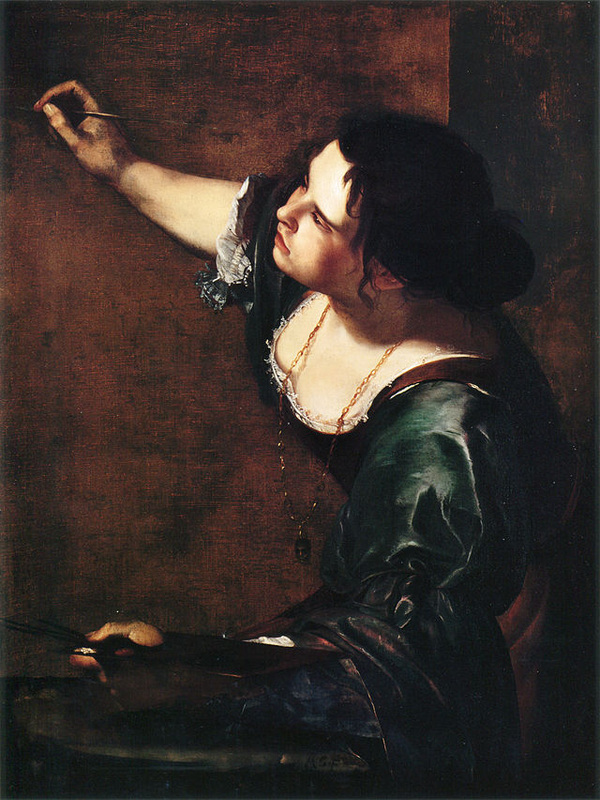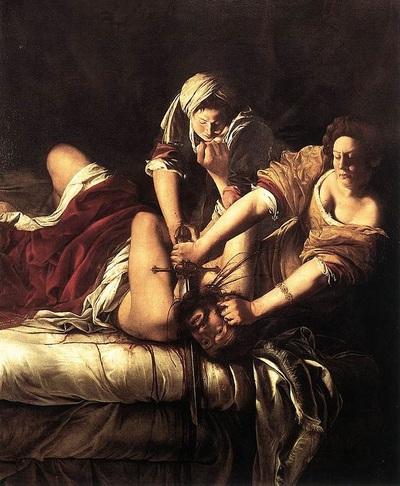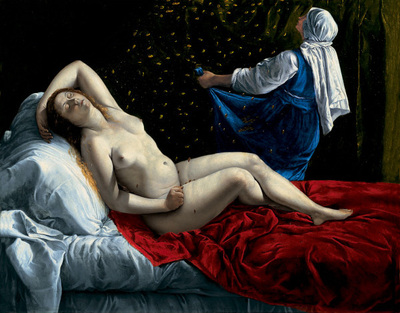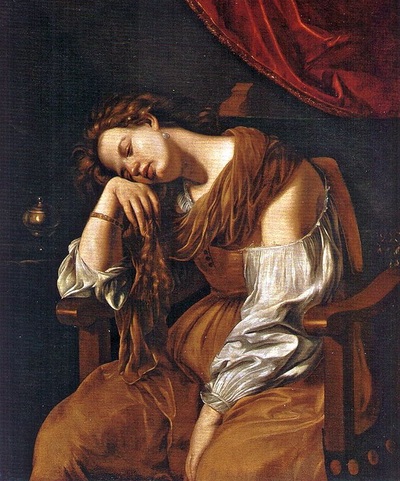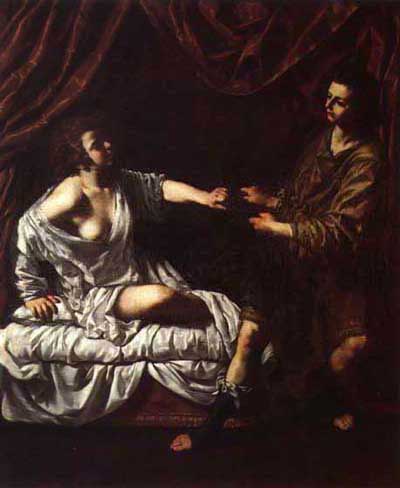ARTEMISIA GENTILESCHI 1593 -1654When Artemisia Gentileschi began her artistic training at the age of 12, she – like all the other garzoni (apprentices) in her father’s workshop in Rome – was mainly occupied with mixing pigments, binding brushes and priming canvases. In her free time she would draw nudes and portraits, and her prodigious talent was quickly spotted by her father, Orazio. Her mother Prudentia had died in 1605. From then on Orazio secretly taught his daughter how to paint. In between performing domestic chores and working in the studio, she painted nude self-portraits, and continued to be her own nude model throughout her life. In order to improve Artemisia’s skills in perspective, Orazio asked his colleague Agostino Tassi to tutor her. It is presumed that Artemisia helped her father and Tassi to paint the figures in the Allegory of Music for the Casino delle Muse, which had been commissioned by Cardinal Scipione Borghese, and that during this time Tassi was overcome by lust for Artemisia and raped her. The 17-year-old is reported to have “suffered severe burns and was badly hurt”, despite having tried to defend herself with the aid of a knife. Over the next nine months, Tassi repeatedly promised to marry her, so she acquiesced to a sexual relationship. It was not until a year after the abusive relationship began, when it was clear that Tassi’s promises were nothing but empty words, that Orazio finally filed a suit against him. Tassi was in fact already married to another woman, who was in turn unfaithful to him. The charges brought against Tassi were “stupro qualificato” (defloration with consent after a promise of marriage) and “stupro violento” (defloration by force), and he was also accused of stealing a painting and owing considerable sums to Orazio. During the trial, Artemisia was subjected to gruelling questioning and physical examinations, including a torturous procedure called the sibille, named after the mythological sibyls who revealed the truth. The punishment for Tassi’s crimes could have been either enforced marriage or death. He was duly sentenced, but the sentence was never implemented as he had influential supporters. To put an end to the scandal, Artemisia was married off to Pierantonio Stiattesi, a mediocre painter who was the brother of her father’s lawyer. Artemisia moved to Florence with her husband and bore him four children during their marriage. In the following years, she processed the experience of Tassi’s violent abuse in paintings on the theme of Judith and Holofernes, as well as other vivid allegories of revenge. Her lover, the brilliant Florentine nobleman Francesco Maringhi, introduced her to Galileo Galilei, who saw to it that she became the first woman to be admitted to the Accademia del Disegno in Florence. After Artemisia’s husband disappeared, Maringhi stayed by her side until her death, and the two were probably secretly married in Naples. Besides this relationship, Artemisia also had other lovers, including the Spanish ambassador to the Holy See. Artemisia often had difficulties completing commissioned works in time and was barely able to cover her debts. After seven years in Florence she fled back to Rome, where she was beaten and insulted by her father and brother. They subsequently broke off all contact with her. Artemisia worked day and night, creating nude paintings of Cleopatra and Danaë and sensual images of Saint Cecilia and Delilah that lustful cardinals concealed behind thick taffeta curtains. Her order book did, however, also contain many commissions for portraits of Roman aristocrats. Artemisia Gentileschi enjoyed international success as an artist and ran flourishing workshops in Rome, Venice, Florence and Naples where she taught important pupils. She was later requested to travel to England via France to help her father fulfil commissions for King Charles I. Nevertheless, she struggled with debt throughout her life and was subjected to repeated attacks on her position as a painter. She is said to have often complained: “If I were a man, I can’t imagine it would have turned out this way.” Caro Bittermann Sources: Roberto Contini et Francesco Solinas (dir.), Artemisia 1593 -1654. Pouvoir, gloire et passion d'une femme peintre, catalogue de l'exposition, musée Maillol/Gallimard, Paris, 2012 Scroll down for German version |
ARTEMISIA GENTILESCHI 1593 -1654 Pigmente anzurühren, Pinsel zu binden und Leinwände zu grundieren, stehen am Anfang ihrer Ausbildung mit zwölf Jahren wie bei allen anderen "garzoni" im Atelier ihres Vaters Orazio in Rom. Nebenbei zeichnet sie Akte und Portraits. Der Vater erkennt ihr Talent darin sofort. Im geheimen unterweist er sie daraufhin in der Malerei. Da ist ihre Mutter schon tot. Zwischen Haushaltspflichten und Atelierdiensten beginnt sie sich selbst nackt zu malen. Bis zu ihrem Tod wird sie sich selbst als Akt-Modell dienen. Um ihre perspektivischen Darstellungsfähigkeiten zu verbessern, bittet Orazio seinen Maler-Kollegen Agostino Tassi, Artemisia zu unterweisen. Es wird vermutet, dass Artemisia ihrem Vater und Tassi dabei hilft, den Pavillon der Musen mit Figurationen zur Allegorie der Musik für den Mäzen Kardinal Borghese auszumalen. Dabei fasst Tassi eine wilde Leidenschaft für Artemisia und er vergewaltigt die 17-Jährige, wobei er ihr "tiefe Brandwunden zufügt und ihr sehr weh tut". Zunächst verteidigt sich Artemisia mit einem Messer. Danach lässt sie sich noch neun Monate lang von ihm immer wieder missbrauchen, weil er ihr unentwegt leere Heiratsversprechen macht. Erst ein Jahr nach Beginn der Übergriffe zeigt der Vater den schon mit einer anderen, allerdings untreuen, Frau verheirateten Tassi an. Die Anklage gegen ihn lautet: "stupro qualificato" (Entjungferung mit leerem Hochzeitsversprechen) und "stupro violente" (mit Gewalt erzwungene Entjungferung), sowie ein Bilder-Diebstahl und hohe Schulden bei Orazio. Artemisia wird unerträglichen Befragungen und körperlichen Untersuchungen unterzogen - von sogenannten "Sybillen", die schon im Mythos dafür zu sorgen haben, aus uns die Wahrheit heraus zu pressen. Die Strafe für Tassis Verbrechen sind entweder Hochzeit oder Tod. Er wird verurteilt, seine Strafe wird aber ausgesetzt, da er mächtige Protegés hat. Artemisia wird mit dem Bruder des Notars ihres Vaters, einem mittelmäßigen Maler, zwangsverheiratet, um dem Skandal ein Ende zu setzen. Mit ihm geht sie nach Florenz und gebiert vier Kinder in dieser Ehe. Die Gewalttaten Tassis wird sie dort in den Folgejahren mit Holofernes&Judith-Darstellungen und anderen drastisch in Szene gesetzten Rache-Allegorien malerisch verarbeiten. Ihr neuer Liebhaber Francesco Maringhi, ein brillanter Kopf, bringt sie mit Galileo Galilei zusammen, der dafür sorgt, dass sie als erste Frau an der Accademia del Disegno in Florenz eingeschrieben wird. Nach dem Verschwinden des Ehemanns bleibt Maringhi an ihrer Seite bis zu ihrem Tod, wahrscheinlich werden sie in Neapel heimlich getraut. Nichtsdestotrotz hatte Artemisia nebenbei noch andere Liebhaber, wie beispielsweise den spanischen Gesandten des Heiligen Stuhls. Immer wieder gerät sie in Verzug mit beauftragten Werken und kann ihre Schulden kaum meistern. Daher flieht sie zurück nach Rom, wo sie von Vater und Bruder geschlagen und beschimpft wird, die schließlich mit ihr den Kontakt abbrechen. Tag und Nacht malt sie besessen an lasziven Akten von Kleopatra und Danae, der heiligen Cäcilie und der Dalila, die wollüstige Kardinäle hinter üppigen Taftvorhängen verstecken. Ihr Auftragsbuch enthält aber auch viele Portrait-Bestellungen der römischen Aristokratie. Trotz ihres internationalen Erfolges und diversen florierenden Werkstätten mit wichtigen Schülern in Rom, Venedig, Florenz und Neapel, aber auch einer späten Reise durch Frankreich nach England, um ihrem Vater zu helfen, Aufträge für den englischen Thron zu bewältigen, kämpft sie ihr Leben lang gegen Schulden und Angriffe auf ihre Stellung als Malerin und sie soll oft geklagt haben: "Wenn ich ein Mann wäre, würden die Dinge anders laufen." Caro Bittermann Quellen: Roberto Contini et Francesco Solinas (dir.), Artemisia 1593 -1654. Pouvoir, gloire et passion d'une femme peintre, catalogue de l'exposition, musée Maillol/Gallimard, Paris, 2012 Hochscrollen zur englischen Version |
